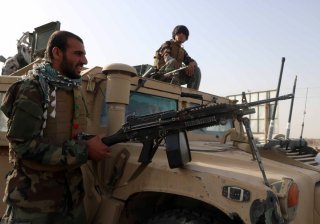The Afghanistan Collapse Continues: Ghani, Dostum Rally Troops in Mazar-i-Sharif
The Taliban’s efforts to capture Mazar-i-Sharif might be harder, as the Taliban infamously carried out a massacre of the city’s occupants after capturing the city from the Northern Alliance in 1998.
On Wednesday, Afghan President Ashraf Ghani visited the city of Mazar-i-Sharif—the largest city in Afghanistan’s north, and one of the final major government strongholds against the Taliban in the region. As the Taliban captured a string of other cities in northern Afghanistan, they have escalated their attacks in the outskirts of the city, and Ghani’s appearance is intended to raise morale among the defenders and dissuade them from abandoning the city.
The Taliban’s northern blitz has caused panic among U.S. strategists. The country’s north has long been viewed as a bulwark of anti-Taliban sentiment, from where the “Northern Alliance” fought against the group during the 1990s when it controlled ninety percent of Afghanistan. A key factor in this opposition has been the ethnic composition of the northernmost districts, which are largely non-Pashtun, the dominant ethnic group within the Taliban.
However, the Taliban have evolved considerably since the 1990s. The group has conducted outreach among Afghanistan’s minority groups, recruiting Tajiks, Turkmens, and other Afghan minorities into its ranks. When the group captured border crossings with Tajikistan in July, ethnically Tajik fighters were tasked with raising the Taliban’s flag over the captured areas.
The Taliban’s efforts to capture Mazar-i-Sharif might be harder, as the Taliban infamously carried out a massacre of the city’s occupants after capturing the city from the Northern Alliance in 1998. Moreover, many of the city’s defenders are natives of the city and members of its local militia and are therefore judged to be less likely to flee than government soldiers, as they have in other areas—most recently including Kandahar and Herat, Afghanistan’s second- and third-largest cities, which fell to the Taliban on Thursday.
Across the country, Afghan security forces have been heavily reliant on support from the U.S. and Afghan air forces, as well as Afghanistan’s American-trained commando units—who by many accounts have engaged in dozens of missions per night and are stretched to their breaking point.
President Joe Biden, who gave the order to withdraw all U.S. forces from Afghanistan by the end of August, has expressed no regrets about this decision. In media statements regarding the issue, the president has repeated that the United States cannot defend the Afghan government forever and that Afghan forces are responsible for the defense of their country.
Meanwhile, the U.S. Embassy in Kabul has requested that all U.S. citizens leave the country, and the State Department has taken steps to expedite the asylum process for many Afghans who served the U.S. as interpreters and other staff, and are therefore wanted by the Taliban.
Trevor Filseth is a current and foreign affairs writer for the National Interest.
Image: Reuters

